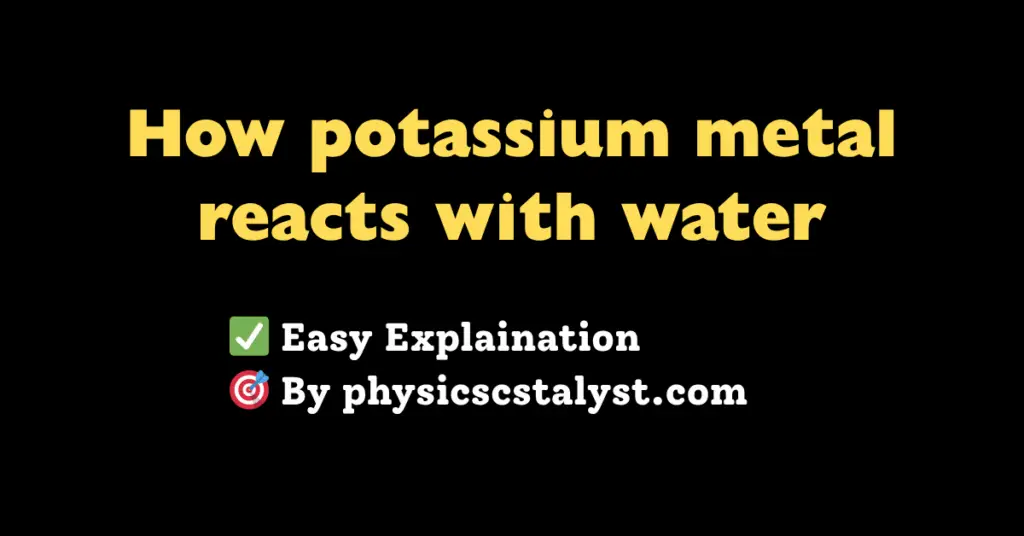Introduction
Potassium (K) is a highly reactive alkali metal found in Group 1 of the periodic table. Its rapid and vivid reaction with water is a classic demonstration of alkali metal reactivity. This phenomenon is important for understanding periodic trends among metals and is frequently discussed in higher secondary chemistry.
Key Features of Potassium
- Physical properties: Soft, silvery metal that can be easily cut with a knife.
- Chemical properties: Extremely reactive, especially with water. Must be stored in kerosene to avoid contact with moisture and oxygen.
Chemical Reaction and Equation
When potassium metal reacts with water, a very rapid and exothermic reaction occurs, producing potassium hydroxide and hydrogen gas.
Balanced chemical equation:
$$
2K(s) + 2H_2O(l) \rightarrow 2KOH(aq) + H_2(g)
$$
- Potassium (solid) combines with water (liquid) to form potassium hydroxide (aqueous) and hydrogen gas (gaseous).[1][2][5]
Reaction Details & Observations
- Speed: Reaction is much faster and more violent than sodium.
- Products:
- Potassium hydroxide (KOH): A colorless, strong alkaline solution.
- Hydrogen gas (H?): Evolves rapidly; can ignite due to the heat produced.
- Heat: The reaction is highly exothermic, releasing enough heat to sometimes melt the potassium and ignite hydrogen.
- Visual cues: Potassium may float, move rapidly on the water surface, and catch fire, displaying a pale lilac flame and often a popping sound.[7][8][1]
Step-by-Step Process
- Potassium is added to water.
- Immediate reaction: Potassium displaces hydrogen from water molecules.
- Formation of KOH: Potassium hydroxide dissolves in water, making it strongly alkaline.
- Hydrogen gas evolution: Produced hydrogen is often ignited by the heat, causing a lilac flame.
Nature of the Reaction
- Exothermic: Releases significant heat energy.
- Vigorous: Potassium may melt and float, sometimes leading to small explosions or sparks.
- Alkaline solution: Due to dissolved KOH.
Why Is Potassium So Reactive?
- Low ionization energy: Potassium easily loses its outer electron.
- Group trend: Reactivity increases down the alkali metal group; potassium reacts faster than sodium, but slower than rubidium.[4][5]
- Strong base formation: The creation of KOH and liberation of hydrogen further drives the reaction.
Safety Precautions
- The reaction is dangerous. It should only be performed in a controlled laboratory setting by trained personnel.
- Potassium should not be handled with bare hands and must be stored under kerosene.
- Protective gear and safety shields are required during demonstrations.
Revision Table
| Feature | Description |
|---|---|
| Reactivity | Very high, rapid and violent |
| Products | KOH (alkaline solution), H? (gas) |
| Equation | $2K + 2H_2O \rightarrow 2KOH + H_2$ |
| Flame | Pale lilac (ignited $H_2$) |
| Type of Reaction | Exothermic |
| Safety | Must be performed with caution |
Conclusion
The reaction of potassium metal with water is highly exothermic and vigorous, leading to the formation of potassium hydroxide and hydrogen gas. The heat generated ignites the hydrogen, producing a characteristic lilac flame and highlighting the high reactivity of potassium among alkali metals. Strict safety precautions are necessary when demonstrating this reaction in laboratories.

